Security of Healthcare System: Components, Best Practices, and Limitations
VerifiedAdded on 2023/05/30
|14
|3916
|166
AI Summary
This article discusses the components and functions of a secured healthcare system, best practices for maintaining security, HIPAA policy, present condition and accomplishments, issues and limitations, and the strength and advantages of using these security systems.
Contribute Materials
Your contribution can guide someone’s learning journey. Share your
documents today.
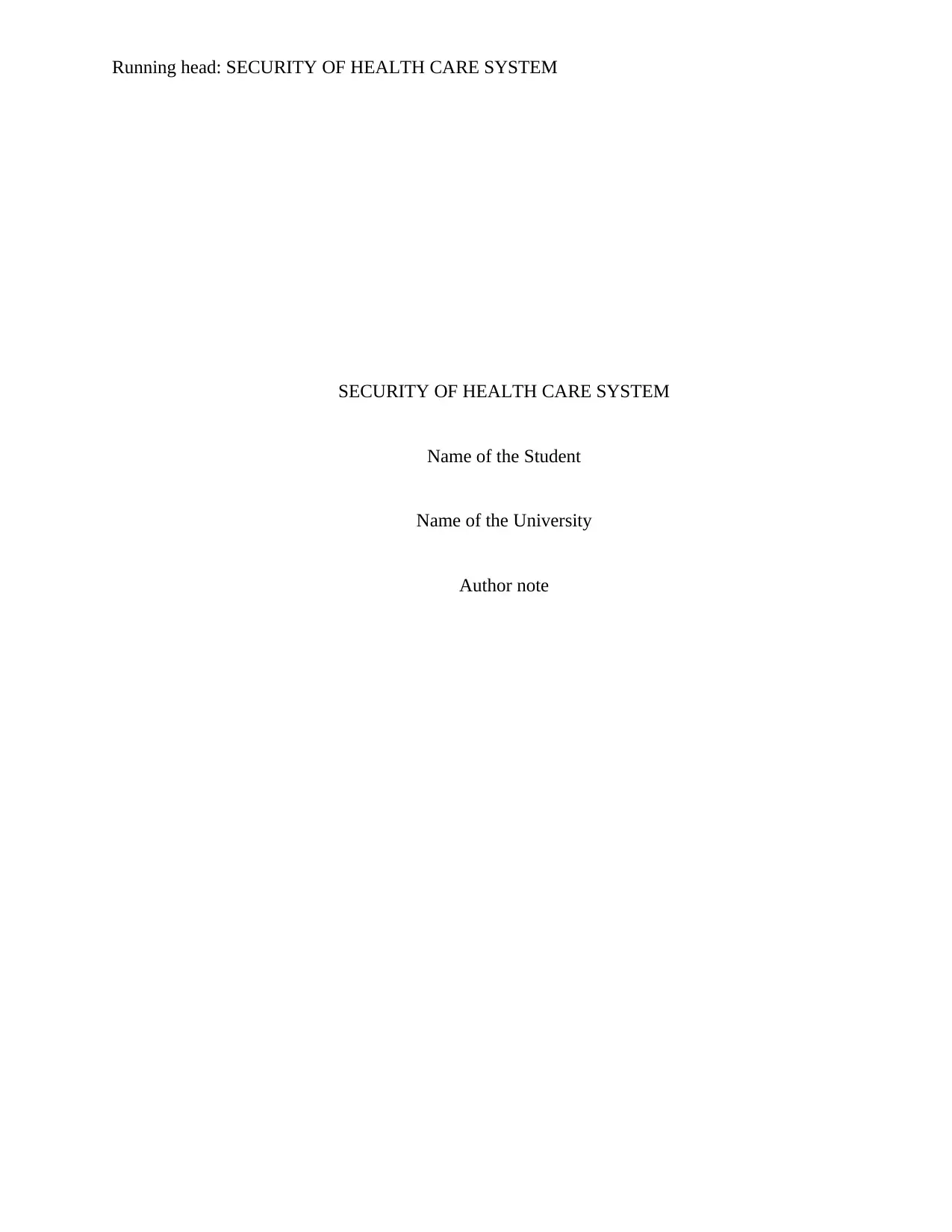
Running head: SECURITY OF HEALTH CARE SYSTEM
SECURITY OF HEALTH CARE SYSTEM
Name of the Student
Name of the University
Author note
SECURITY OF HEALTH CARE SYSTEM
Name of the Student
Name of the University
Author note
Secure Best Marks with AI Grader
Need help grading? Try our AI Grader for instant feedback on your assignments.
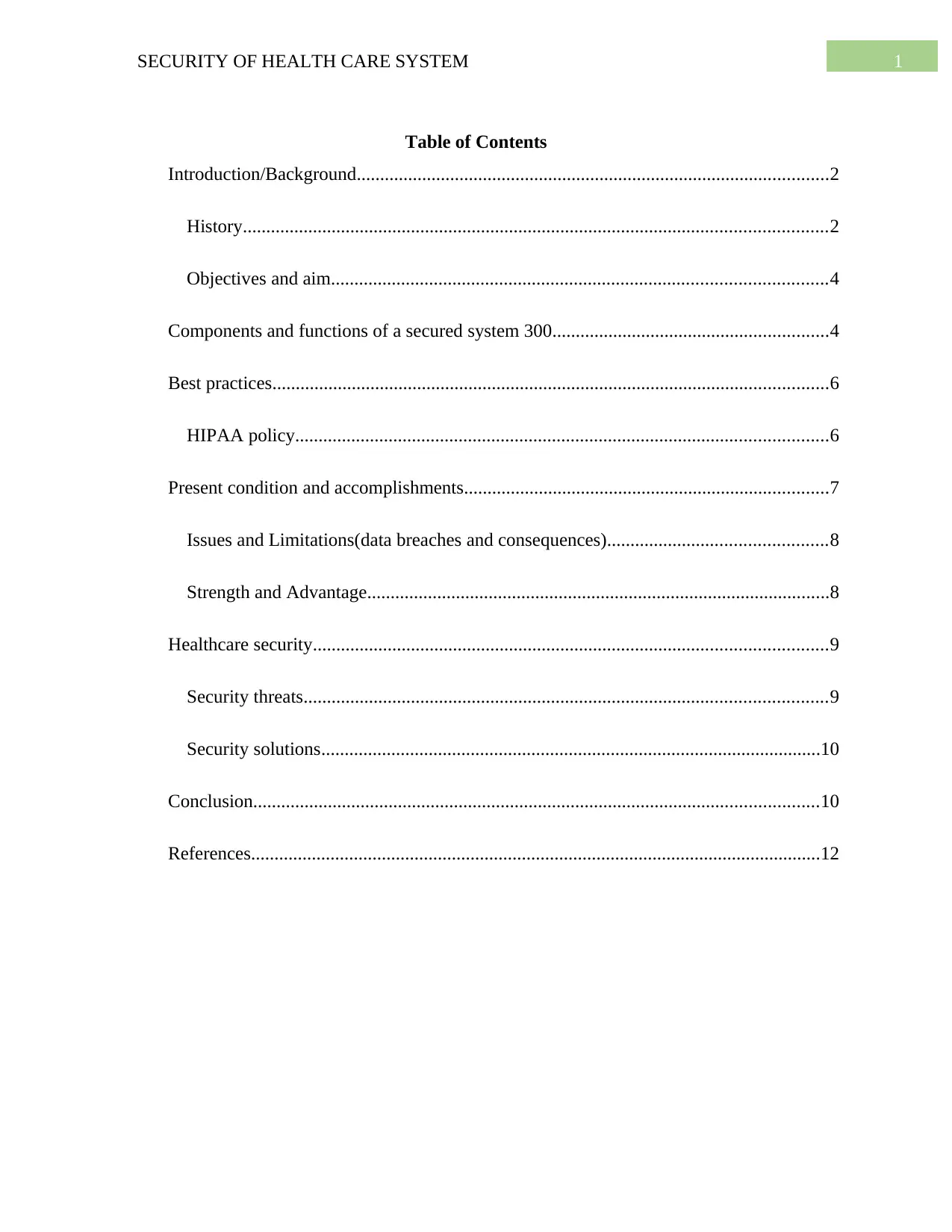
1SECURITY OF HEALTH CARE SYSTEM
Table of Contents
Introduction/Background.....................................................................................................2
History.............................................................................................................................2
Objectives and aim..........................................................................................................4
Components and functions of a secured system 300...........................................................4
Best practices.......................................................................................................................6
HIPAA policy..................................................................................................................6
Present condition and accomplishments..............................................................................7
Issues and Limitations(data breaches and consequences)...............................................8
Strength and Advantage...................................................................................................8
Healthcare security..............................................................................................................9
Security threats................................................................................................................9
Security solutions...........................................................................................................10
Conclusion.........................................................................................................................10
References..........................................................................................................................12
Table of Contents
Introduction/Background.....................................................................................................2
History.............................................................................................................................2
Objectives and aim..........................................................................................................4
Components and functions of a secured system 300...........................................................4
Best practices.......................................................................................................................6
HIPAA policy..................................................................................................................6
Present condition and accomplishments..............................................................................7
Issues and Limitations(data breaches and consequences)...............................................8
Strength and Advantage...................................................................................................8
Healthcare security..............................................................................................................9
Security threats................................................................................................................9
Security solutions...........................................................................................................10
Conclusion.........................................................................................................................10
References..........................................................................................................................12
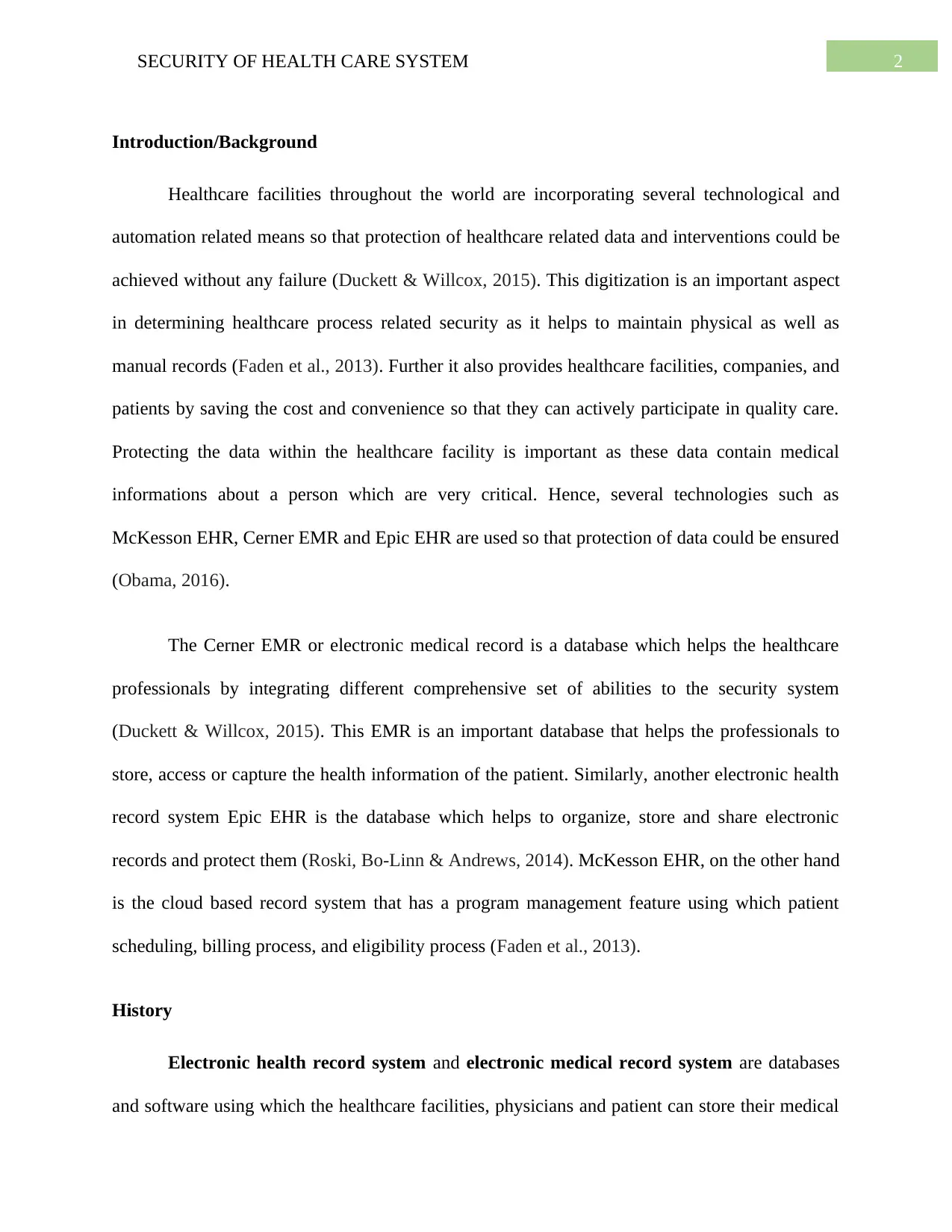
2SECURITY OF HEALTH CARE SYSTEM
Introduction/Background
Healthcare facilities throughout the world are incorporating several technological and
automation related means so that protection of healthcare related data and interventions could be
achieved without any failure (Duckett & Willcox, 2015). This digitization is an important aspect
in determining healthcare process related security as it helps to maintain physical as well as
manual records (Faden et al., 2013). Further it also provides healthcare facilities, companies, and
patients by saving the cost and convenience so that they can actively participate in quality care.
Protecting the data within the healthcare facility is important as these data contain medical
informations about a person which are very critical. Hence, several technologies such as
McKesson EHR, Cerner EMR and Epic EHR are used so that protection of data could be ensured
(Obama, 2016).
The Cerner EMR or electronic medical record is a database which helps the healthcare
professionals by integrating different comprehensive set of abilities to the security system
(Duckett & Willcox, 2015). This EMR is an important database that helps the professionals to
store, access or capture the health information of the patient. Similarly, another electronic health
record system Epic EHR is the database which helps to organize, store and share electronic
records and protect them (Roski, Bo-Linn & Andrews, 2014). McKesson EHR, on the other hand
is the cloud based record system that has a program management feature using which patient
scheduling, billing process, and eligibility process (Faden et al., 2013).
History
Electronic health record system and electronic medical record system are databases
and software using which the healthcare facilities, physicians and patient can store their medical
Introduction/Background
Healthcare facilities throughout the world are incorporating several technological and
automation related means so that protection of healthcare related data and interventions could be
achieved without any failure (Duckett & Willcox, 2015). This digitization is an important aspect
in determining healthcare process related security as it helps to maintain physical as well as
manual records (Faden et al., 2013). Further it also provides healthcare facilities, companies, and
patients by saving the cost and convenience so that they can actively participate in quality care.
Protecting the data within the healthcare facility is important as these data contain medical
informations about a person which are very critical. Hence, several technologies such as
McKesson EHR, Cerner EMR and Epic EHR are used so that protection of data could be ensured
(Obama, 2016).
The Cerner EMR or electronic medical record is a database which helps the healthcare
professionals by integrating different comprehensive set of abilities to the security system
(Duckett & Willcox, 2015). This EMR is an important database that helps the professionals to
store, access or capture the health information of the patient. Similarly, another electronic health
record system Epic EHR is the database which helps to organize, store and share electronic
records and protect them (Roski, Bo-Linn & Andrews, 2014). McKesson EHR, on the other hand
is the cloud based record system that has a program management feature using which patient
scheduling, billing process, and eligibility process (Faden et al., 2013).
History
Electronic health record system and electronic medical record system are databases
and software using which the healthcare facilities, physicians and patient can store their medical
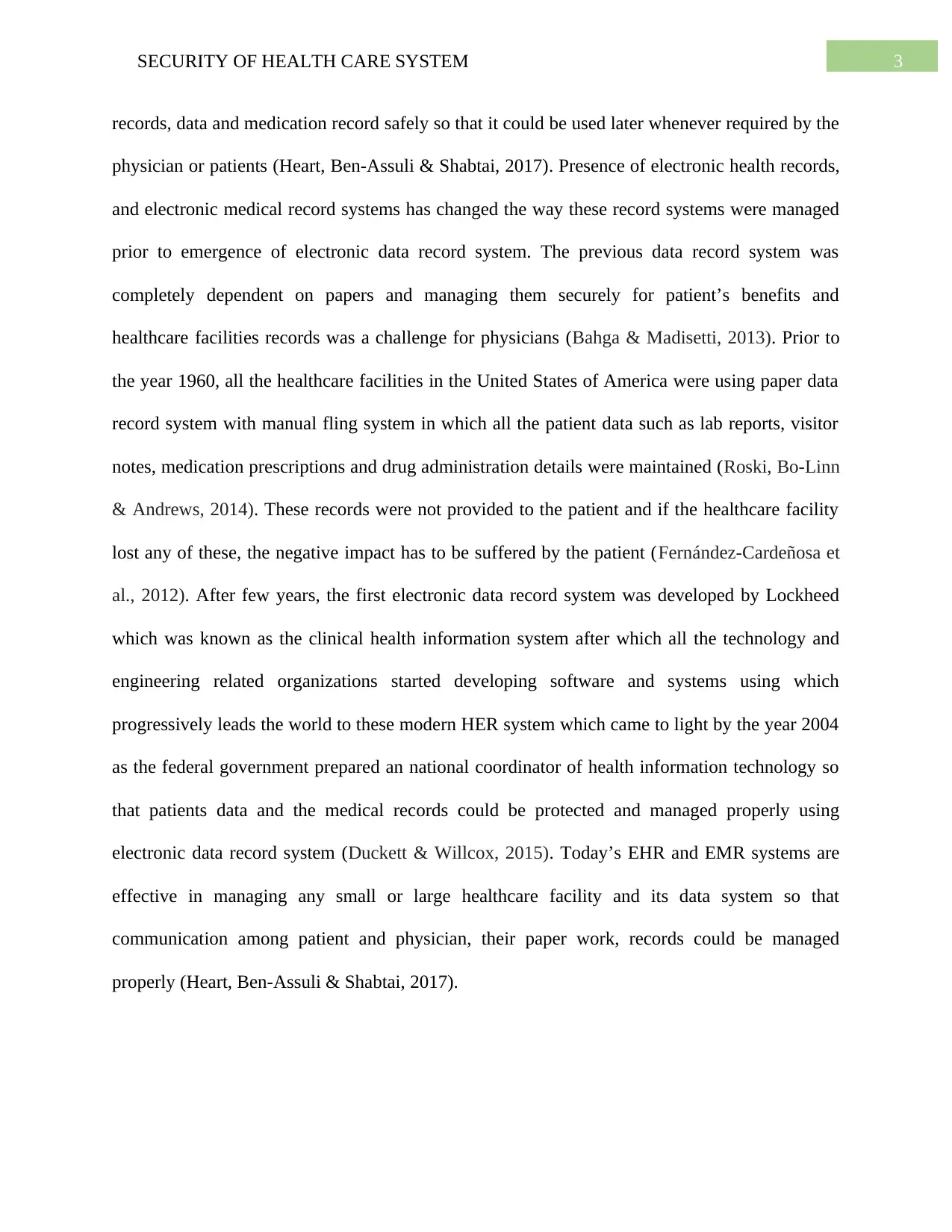
3SECURITY OF HEALTH CARE SYSTEM
records, data and medication record safely so that it could be used later whenever required by the
physician or patients (Heart, Ben-Assuli & Shabtai, 2017). Presence of electronic health records,
and electronic medical record systems has changed the way these record systems were managed
prior to emergence of electronic data record system. The previous data record system was
completely dependent on papers and managing them securely for patient’s benefits and
healthcare facilities records was a challenge for physicians (Bahga & Madisetti, 2013). Prior to
the year 1960, all the healthcare facilities in the United States of America were using paper data
record system with manual fling system in which all the patient data such as lab reports, visitor
notes, medication prescriptions and drug administration details were maintained (Roski, Bo-Linn
& Andrews, 2014). These records were not provided to the patient and if the healthcare facility
lost any of these, the negative impact has to be suffered by the patient (Fernández-Cardeñosa et
al., 2012). After few years, the first electronic data record system was developed by Lockheed
which was known as the clinical health information system after which all the technology and
engineering related organizations started developing software and systems using which
progressively leads the world to these modern HER system which came to light by the year 2004
as the federal government prepared an national coordinator of health information technology so
that patients data and the medical records could be protected and managed properly using
electronic data record system (Duckett & Willcox, 2015). Today’s EHR and EMR systems are
effective in managing any small or large healthcare facility and its data system so that
communication among patient and physician, their paper work, records could be managed
properly (Heart, Ben-Assuli & Shabtai, 2017).
records, data and medication record safely so that it could be used later whenever required by the
physician or patients (Heart, Ben-Assuli & Shabtai, 2017). Presence of electronic health records,
and electronic medical record systems has changed the way these record systems were managed
prior to emergence of electronic data record system. The previous data record system was
completely dependent on papers and managing them securely for patient’s benefits and
healthcare facilities records was a challenge for physicians (Bahga & Madisetti, 2013). Prior to
the year 1960, all the healthcare facilities in the United States of America were using paper data
record system with manual fling system in which all the patient data such as lab reports, visitor
notes, medication prescriptions and drug administration details were maintained (Roski, Bo-Linn
& Andrews, 2014). These records were not provided to the patient and if the healthcare facility
lost any of these, the negative impact has to be suffered by the patient (Fernández-Cardeñosa et
al., 2012). After few years, the first electronic data record system was developed by Lockheed
which was known as the clinical health information system after which all the technology and
engineering related organizations started developing software and systems using which
progressively leads the world to these modern HER system which came to light by the year 2004
as the federal government prepared an national coordinator of health information technology so
that patients data and the medical records could be protected and managed properly using
electronic data record system (Duckett & Willcox, 2015). Today’s EHR and EMR systems are
effective in managing any small or large healthcare facility and its data system so that
communication among patient and physician, their paper work, records could be managed
properly (Heart, Ben-Assuli & Shabtai, 2017).
Secure Best Marks with AI Grader
Need help grading? Try our AI Grader for instant feedback on your assignments.
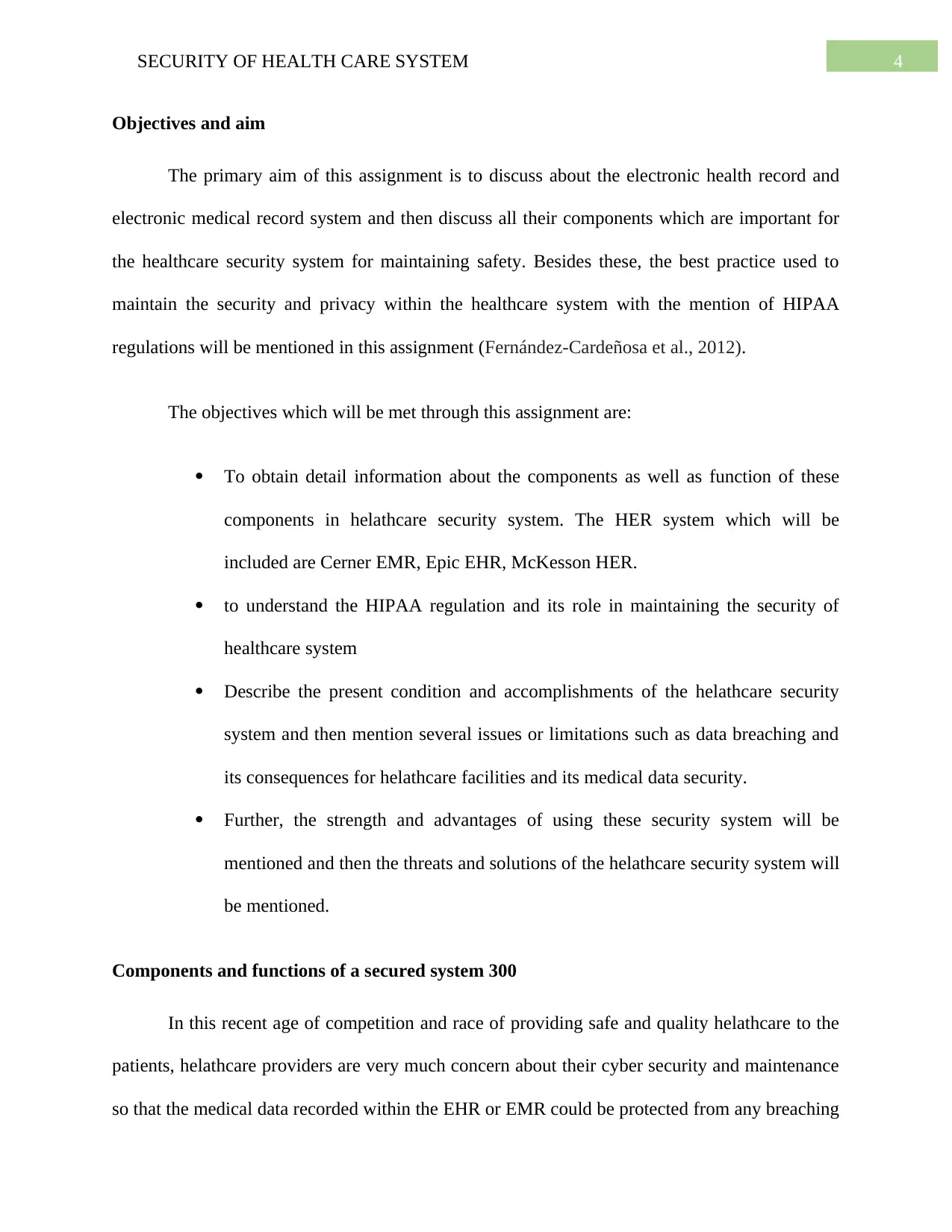
4SECURITY OF HEALTH CARE SYSTEM
Objectives and aim
The primary aim of this assignment is to discuss about the electronic health record and
electronic medical record system and then discuss all their components which are important for
the healthcare security system for maintaining safety. Besides these, the best practice used to
maintain the security and privacy within the healthcare system with the mention of HIPAA
regulations will be mentioned in this assignment (Fernández-Cardeñosa et al., 2012).
The objectives which will be met through this assignment are:
To obtain detail information about the components as well as function of these
components in helathcare security system. The HER system which will be
included are Cerner EMR, Epic EHR, McKesson HER.
to understand the HIPAA regulation and its role in maintaining the security of
healthcare system
Describe the present condition and accomplishments of the helathcare security
system and then mention several issues or limitations such as data breaching and
its consequences for helathcare facilities and its medical data security.
Further, the strength and advantages of using these security system will be
mentioned and then the threats and solutions of the helathcare security system will
be mentioned.
Components and functions of a secured system 300
In this recent age of competition and race of providing safe and quality helathcare to the
patients, helathcare providers are very much concern about their cyber security and maintenance
so that the medical data recorded within the EHR or EMR could be protected from any breaching
Objectives and aim
The primary aim of this assignment is to discuss about the electronic health record and
electronic medical record system and then discuss all their components which are important for
the healthcare security system for maintaining safety. Besides these, the best practice used to
maintain the security and privacy within the healthcare system with the mention of HIPAA
regulations will be mentioned in this assignment (Fernández-Cardeñosa et al., 2012).
The objectives which will be met through this assignment are:
To obtain detail information about the components as well as function of these
components in helathcare security system. The HER system which will be
included are Cerner EMR, Epic EHR, McKesson HER.
to understand the HIPAA regulation and its role in maintaining the security of
healthcare system
Describe the present condition and accomplishments of the helathcare security
system and then mention several issues or limitations such as data breaching and
its consequences for helathcare facilities and its medical data security.
Further, the strength and advantages of using these security system will be
mentioned and then the threats and solutions of the helathcare security system will
be mentioned.
Components and functions of a secured system 300
In this recent age of competition and race of providing safe and quality helathcare to the
patients, helathcare providers are very much concern about their cyber security and maintenance
so that the medical data recorded within the EHR or EMR could be protected from any breaching
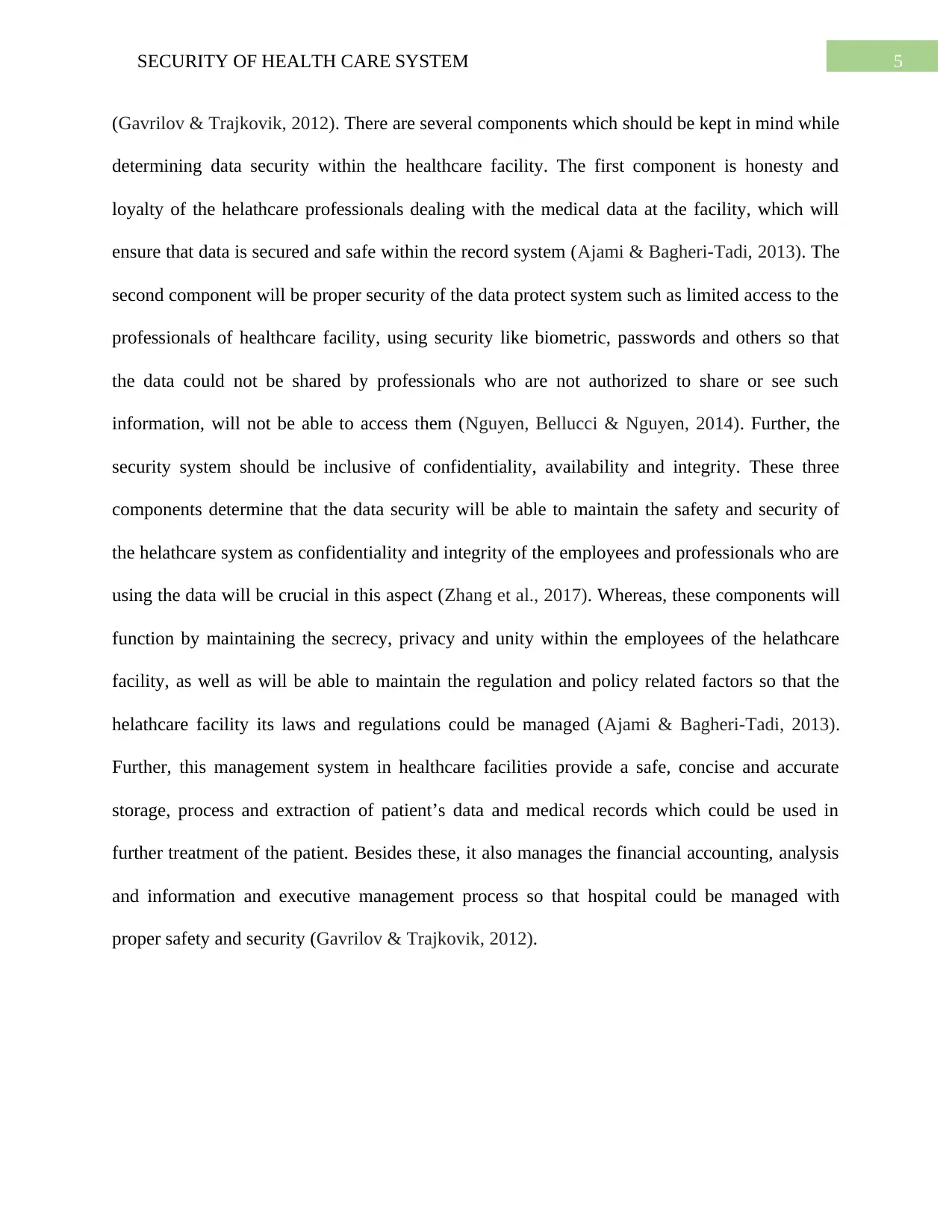
5SECURITY OF HEALTH CARE SYSTEM
(Gavrilov & Trajkovik, 2012). There are several components which should be kept in mind while
determining data security within the healthcare facility. The first component is honesty and
loyalty of the helathcare professionals dealing with the medical data at the facility, which will
ensure that data is secured and safe within the record system (Ajami & Bagheri-Tadi, 2013). The
second component will be proper security of the data protect system such as limited access to the
professionals of healthcare facility, using security like biometric, passwords and others so that
the data could not be shared by professionals who are not authorized to share or see such
information, will not be able to access them (Nguyen, Bellucci & Nguyen, 2014). Further, the
security system should be inclusive of confidentiality, availability and integrity. These three
components determine that the data security will be able to maintain the safety and security of
the helathcare system as confidentiality and integrity of the employees and professionals who are
using the data will be crucial in this aspect (Zhang et al., 2017). Whereas, these components will
function by maintaining the secrecy, privacy and unity within the employees of the helathcare
facility, as well as will be able to maintain the regulation and policy related factors so that the
helathcare facility its laws and regulations could be managed (Ajami & Bagheri-Tadi, 2013).
Further, this management system in healthcare facilities provide a safe, concise and accurate
storage, process and extraction of patient’s data and medical records which could be used in
further treatment of the patient. Besides these, it also manages the financial accounting, analysis
and information and executive management process so that hospital could be managed with
proper safety and security (Gavrilov & Trajkovik, 2012).
(Gavrilov & Trajkovik, 2012). There are several components which should be kept in mind while
determining data security within the healthcare facility. The first component is honesty and
loyalty of the helathcare professionals dealing with the medical data at the facility, which will
ensure that data is secured and safe within the record system (Ajami & Bagheri-Tadi, 2013). The
second component will be proper security of the data protect system such as limited access to the
professionals of healthcare facility, using security like biometric, passwords and others so that
the data could not be shared by professionals who are not authorized to share or see such
information, will not be able to access them (Nguyen, Bellucci & Nguyen, 2014). Further, the
security system should be inclusive of confidentiality, availability and integrity. These three
components determine that the data security will be able to maintain the safety and security of
the helathcare system as confidentiality and integrity of the employees and professionals who are
using the data will be crucial in this aspect (Zhang et al., 2017). Whereas, these components will
function by maintaining the secrecy, privacy and unity within the employees of the helathcare
facility, as well as will be able to maintain the regulation and policy related factors so that the
helathcare facility its laws and regulations could be managed (Ajami & Bagheri-Tadi, 2013).
Further, this management system in healthcare facilities provide a safe, concise and accurate
storage, process and extraction of patient’s data and medical records which could be used in
further treatment of the patient. Besides these, it also manages the financial accounting, analysis
and information and executive management process so that hospital could be managed with
proper safety and security (Gavrilov & Trajkovik, 2012).
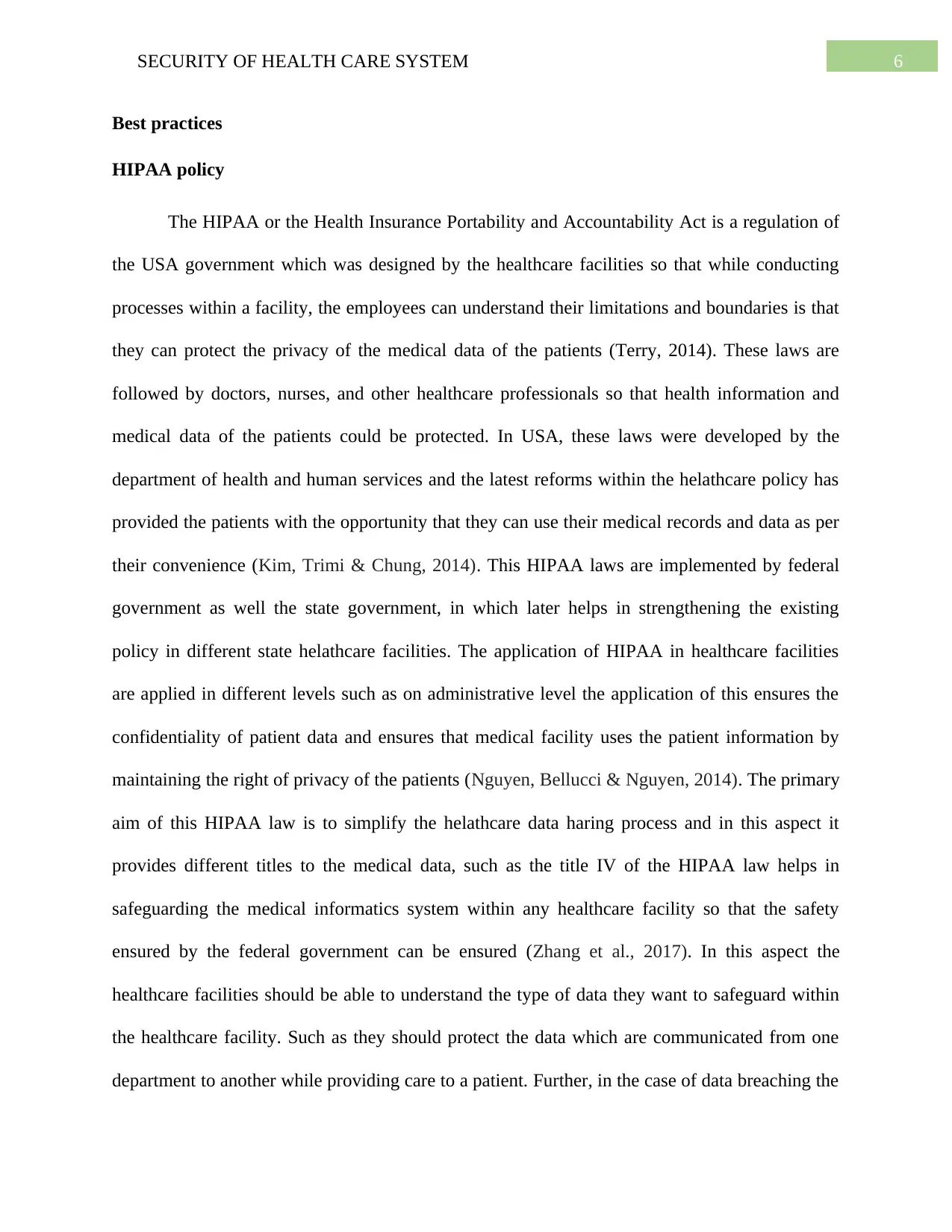
6SECURITY OF HEALTH CARE SYSTEM
Best practices
HIPAA policy
The HIPAA or the Health Insurance Portability and Accountability Act is a regulation of
the USA government which was designed by the healthcare facilities so that while conducting
processes within a facility, the employees can understand their limitations and boundaries is that
they can protect the privacy of the medical data of the patients (Terry, 2014). These laws are
followed by doctors, nurses, and other healthcare professionals so that health information and
medical data of the patients could be protected. In USA, these laws were developed by the
department of health and human services and the latest reforms within the helathcare policy has
provided the patients with the opportunity that they can use their medical records and data as per
their convenience (Kim, Trimi & Chung, 2014). This HIPAA laws are implemented by federal
government as well the state government, in which later helps in strengthening the existing
policy in different state helathcare facilities. The application of HIPAA in healthcare facilities
are applied in different levels such as on administrative level the application of this ensures the
confidentiality of patient data and ensures that medical facility uses the patient information by
maintaining the right of privacy of the patients (Nguyen, Bellucci & Nguyen, 2014). The primary
aim of this HIPAA law is to simplify the helathcare data haring process and in this aspect it
provides different titles to the medical data, such as the title IV of the HIPAA law helps in
safeguarding the medical informatics system within any healthcare facility so that the safety
ensured by the federal government can be ensured (Zhang et al., 2017). In this aspect the
healthcare facilities should be able to understand the type of data they want to safeguard within
the healthcare facility. Such as they should protect the data which are communicated from one
department to another while providing care to a patient. Further, in the case of data breaching the
Best practices
HIPAA policy
The HIPAA or the Health Insurance Portability and Accountability Act is a regulation of
the USA government which was designed by the healthcare facilities so that while conducting
processes within a facility, the employees can understand their limitations and boundaries is that
they can protect the privacy of the medical data of the patients (Terry, 2014). These laws are
followed by doctors, nurses, and other healthcare professionals so that health information and
medical data of the patients could be protected. In USA, these laws were developed by the
department of health and human services and the latest reforms within the helathcare policy has
provided the patients with the opportunity that they can use their medical records and data as per
their convenience (Kim, Trimi & Chung, 2014). This HIPAA laws are implemented by federal
government as well the state government, in which later helps in strengthening the existing
policy in different state helathcare facilities. The application of HIPAA in healthcare facilities
are applied in different levels such as on administrative level the application of this ensures the
confidentiality of patient data and ensures that medical facility uses the patient information by
maintaining the right of privacy of the patients (Nguyen, Bellucci & Nguyen, 2014). The primary
aim of this HIPAA law is to simplify the helathcare data haring process and in this aspect it
provides different titles to the medical data, such as the title IV of the HIPAA law helps in
safeguarding the medical informatics system within any healthcare facility so that the safety
ensured by the federal government can be ensured (Zhang et al., 2017). In this aspect the
healthcare facilities should be able to understand the type of data they want to safeguard within
the healthcare facility. Such as they should protect the data which are communicated from one
department to another while providing care to a patient. Further, in the case of data breaching the
Paraphrase This Document
Need a fresh take? Get an instant paraphrase of this document with our AI Paraphraser
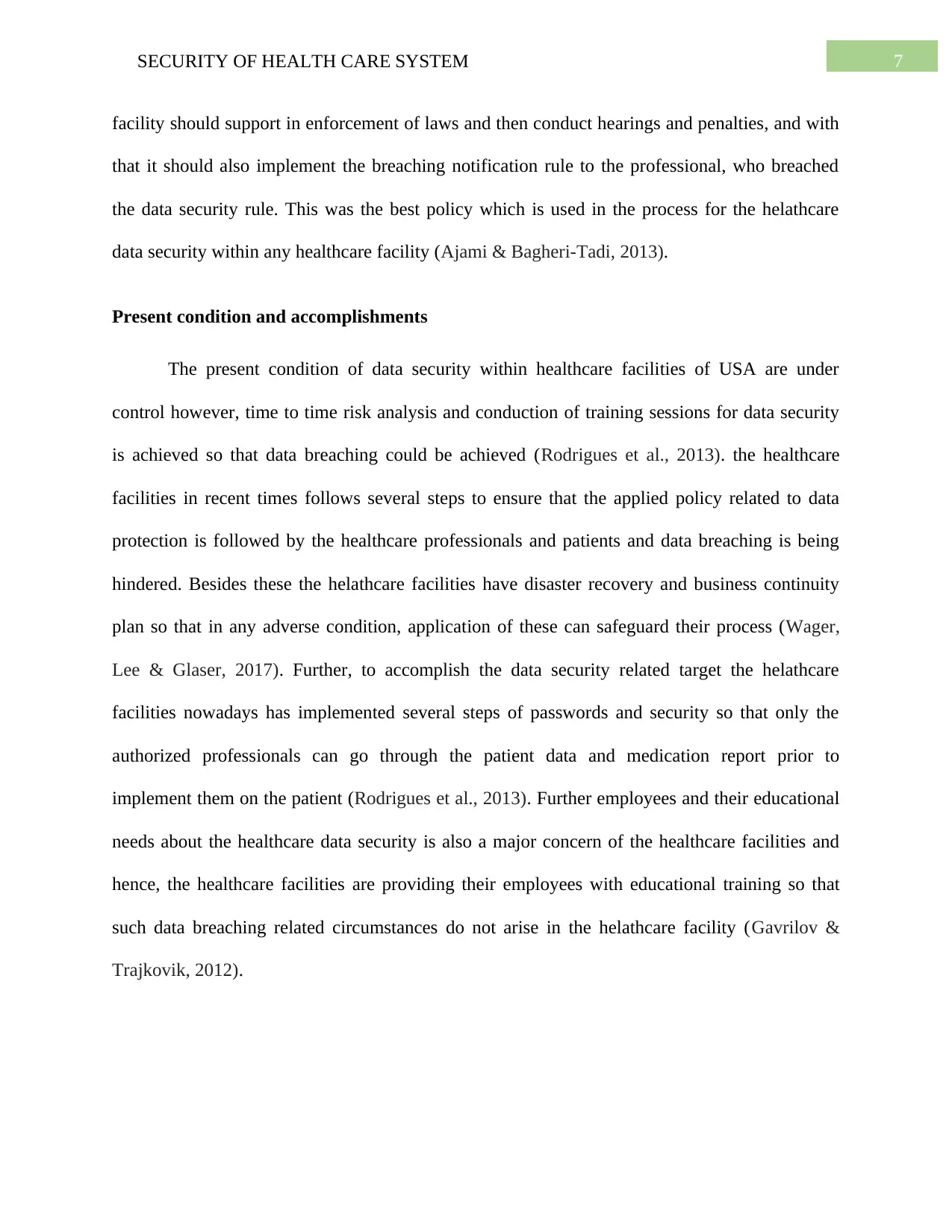
7SECURITY OF HEALTH CARE SYSTEM
facility should support in enforcement of laws and then conduct hearings and penalties, and with
that it should also implement the breaching notification rule to the professional, who breached
the data security rule. This was the best policy which is used in the process for the helathcare
data security within any healthcare facility (Ajami & Bagheri-Tadi, 2013).
Present condition and accomplishments
The present condition of data security within healthcare facilities of USA are under
control however, time to time risk analysis and conduction of training sessions for data security
is achieved so that data breaching could be achieved (Rodrigues et al., 2013). the healthcare
facilities in recent times follows several steps to ensure that the applied policy related to data
protection is followed by the healthcare professionals and patients and data breaching is being
hindered. Besides these the helathcare facilities have disaster recovery and business continuity
plan so that in any adverse condition, application of these can safeguard their process (Wager,
Lee & Glaser, 2017). Further, to accomplish the data security related target the helathcare
facilities nowadays has implemented several steps of passwords and security so that only the
authorized professionals can go through the patient data and medication report prior to
implement them on the patient (Rodrigues et al., 2013). Further employees and their educational
needs about the healthcare data security is also a major concern of the healthcare facilities and
hence, the healthcare facilities are providing their employees with educational training so that
such data breaching related circumstances do not arise in the helathcare facility (Gavrilov &
Trajkovik, 2012).
facility should support in enforcement of laws and then conduct hearings and penalties, and with
that it should also implement the breaching notification rule to the professional, who breached
the data security rule. This was the best policy which is used in the process for the helathcare
data security within any healthcare facility (Ajami & Bagheri-Tadi, 2013).
Present condition and accomplishments
The present condition of data security within healthcare facilities of USA are under
control however, time to time risk analysis and conduction of training sessions for data security
is achieved so that data breaching could be achieved (Rodrigues et al., 2013). the healthcare
facilities in recent times follows several steps to ensure that the applied policy related to data
protection is followed by the healthcare professionals and patients and data breaching is being
hindered. Besides these the helathcare facilities have disaster recovery and business continuity
plan so that in any adverse condition, application of these can safeguard their process (Wager,
Lee & Glaser, 2017). Further, to accomplish the data security related target the helathcare
facilities nowadays has implemented several steps of passwords and security so that only the
authorized professionals can go through the patient data and medication report prior to
implement them on the patient (Rodrigues et al., 2013). Further employees and their educational
needs about the healthcare data security is also a major concern of the healthcare facilities and
hence, the healthcare facilities are providing their employees with educational training so that
such data breaching related circumstances do not arise in the helathcare facility (Gavrilov &
Trajkovik, 2012).
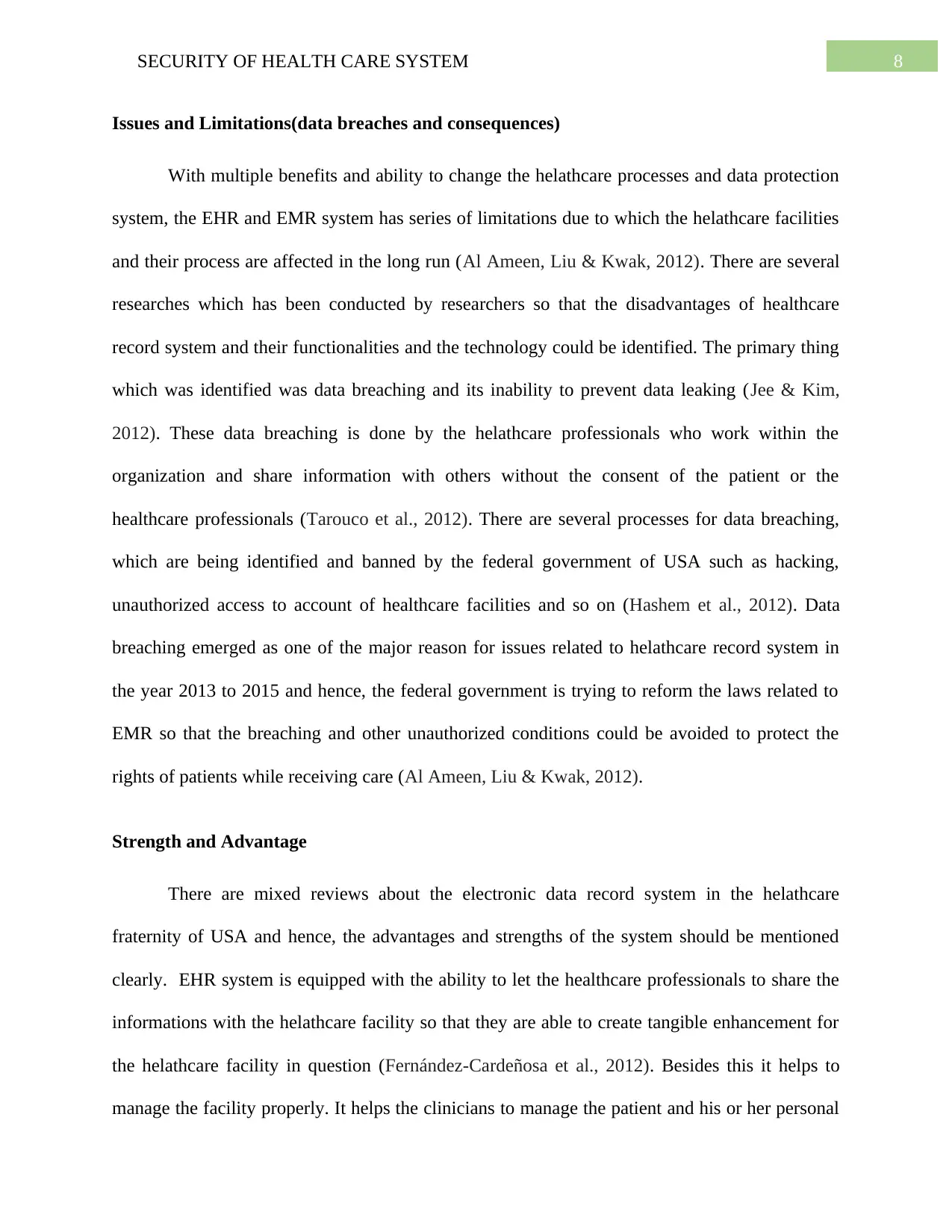
8SECURITY OF HEALTH CARE SYSTEM
Issues and Limitations(data breaches and consequences)
With multiple benefits and ability to change the helathcare processes and data protection
system, the EHR and EMR system has series of limitations due to which the helathcare facilities
and their process are affected in the long run (Al Ameen, Liu & Kwak, 2012). There are several
researches which has been conducted by researchers so that the disadvantages of healthcare
record system and their functionalities and the technology could be identified. The primary thing
which was identified was data breaching and its inability to prevent data leaking (Jee & Kim,
2012). These data breaching is done by the helathcare professionals who work within the
organization and share information with others without the consent of the patient or the
healthcare professionals (Tarouco et al., 2012). There are several processes for data breaching,
which are being identified and banned by the federal government of USA such as hacking,
unauthorized access to account of healthcare facilities and so on (Hashem et al., 2012). Data
breaching emerged as one of the major reason for issues related to helathcare record system in
the year 2013 to 2015 and hence, the federal government is trying to reform the laws related to
EMR so that the breaching and other unauthorized conditions could be avoided to protect the
rights of patients while receiving care (Al Ameen, Liu & Kwak, 2012).
Strength and Advantage
There are mixed reviews about the electronic data record system in the helathcare
fraternity of USA and hence, the advantages and strengths of the system should be mentioned
clearly. EHR system is equipped with the ability to let the healthcare professionals to share the
informations with the helathcare facility so that they are able to create tangible enhancement for
the helathcare facility in question (Fernández-Cardeñosa et al., 2012). Besides this it helps to
manage the facility properly. It helps the clinicians to manage the patient and his or her personal
Issues and Limitations(data breaches and consequences)
With multiple benefits and ability to change the helathcare processes and data protection
system, the EHR and EMR system has series of limitations due to which the helathcare facilities
and their process are affected in the long run (Al Ameen, Liu & Kwak, 2012). There are several
researches which has been conducted by researchers so that the disadvantages of healthcare
record system and their functionalities and the technology could be identified. The primary thing
which was identified was data breaching and its inability to prevent data leaking (Jee & Kim,
2012). These data breaching is done by the helathcare professionals who work within the
organization and share information with others without the consent of the patient or the
healthcare professionals (Tarouco et al., 2012). There are several processes for data breaching,
which are being identified and banned by the federal government of USA such as hacking,
unauthorized access to account of healthcare facilities and so on (Hashem et al., 2012). Data
breaching emerged as one of the major reason for issues related to helathcare record system in
the year 2013 to 2015 and hence, the federal government is trying to reform the laws related to
EMR so that the breaching and other unauthorized conditions could be avoided to protect the
rights of patients while receiving care (Al Ameen, Liu & Kwak, 2012).
Strength and Advantage
There are mixed reviews about the electronic data record system in the helathcare
fraternity of USA and hence, the advantages and strengths of the system should be mentioned
clearly. EHR system is equipped with the ability to let the healthcare professionals to share the
informations with the helathcare facility so that they are able to create tangible enhancement for
the helathcare facility in question (Fernández-Cardeñosa et al., 2012). Besides this it helps to
manage the facility properly. It helps the clinicians to manage the patient and his or her personal
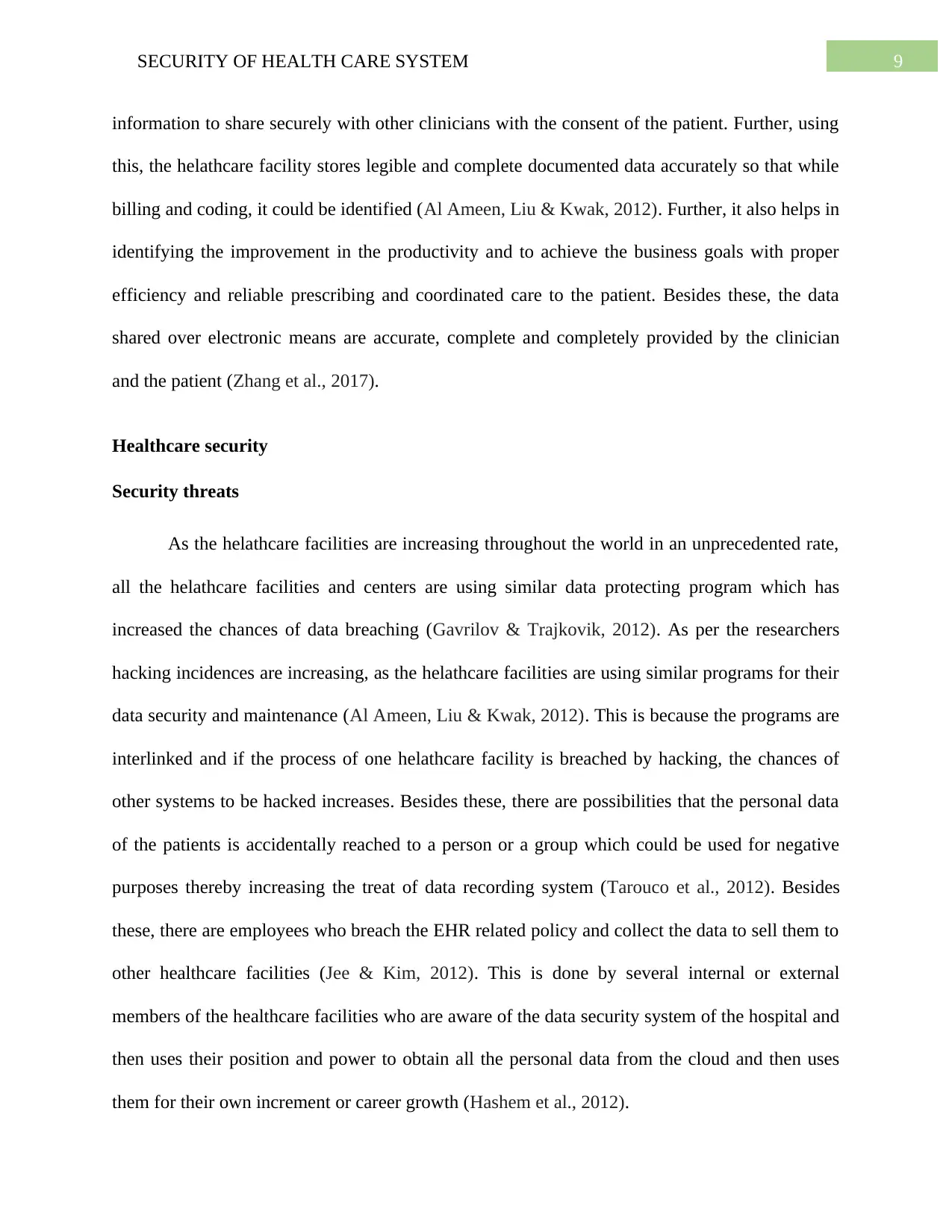
9SECURITY OF HEALTH CARE SYSTEM
information to share securely with other clinicians with the consent of the patient. Further, using
this, the helathcare facility stores legible and complete documented data accurately so that while
billing and coding, it could be identified (Al Ameen, Liu & Kwak, 2012). Further, it also helps in
identifying the improvement in the productivity and to achieve the business goals with proper
efficiency and reliable prescribing and coordinated care to the patient. Besides these, the data
shared over electronic means are accurate, complete and completely provided by the clinician
and the patient (Zhang et al., 2017).
Healthcare security
Security threats
As the helathcare facilities are increasing throughout the world in an unprecedented rate,
all the helathcare facilities and centers are using similar data protecting program which has
increased the chances of data breaching (Gavrilov & Trajkovik, 2012). As per the researchers
hacking incidences are increasing, as the helathcare facilities are using similar programs for their
data security and maintenance (Al Ameen, Liu & Kwak, 2012). This is because the programs are
interlinked and if the process of one helathcare facility is breached by hacking, the chances of
other systems to be hacked increases. Besides these, there are possibilities that the personal data
of the patients is accidentally reached to a person or a group which could be used for negative
purposes thereby increasing the treat of data recording system (Tarouco et al., 2012). Besides
these, there are employees who breach the EHR related policy and collect the data to sell them to
other healthcare facilities (Jee & Kim, 2012). This is done by several internal or external
members of the healthcare facilities who are aware of the data security system of the hospital and
then uses their position and power to obtain all the personal data from the cloud and then uses
them for their own increment or career growth (Hashem et al., 2012).
information to share securely with other clinicians with the consent of the patient. Further, using
this, the helathcare facility stores legible and complete documented data accurately so that while
billing and coding, it could be identified (Al Ameen, Liu & Kwak, 2012). Further, it also helps in
identifying the improvement in the productivity and to achieve the business goals with proper
efficiency and reliable prescribing and coordinated care to the patient. Besides these, the data
shared over electronic means are accurate, complete and completely provided by the clinician
and the patient (Zhang et al., 2017).
Healthcare security
Security threats
As the helathcare facilities are increasing throughout the world in an unprecedented rate,
all the helathcare facilities and centers are using similar data protecting program which has
increased the chances of data breaching (Gavrilov & Trajkovik, 2012). As per the researchers
hacking incidences are increasing, as the helathcare facilities are using similar programs for their
data security and maintenance (Al Ameen, Liu & Kwak, 2012). This is because the programs are
interlinked and if the process of one helathcare facility is breached by hacking, the chances of
other systems to be hacked increases. Besides these, there are possibilities that the personal data
of the patients is accidentally reached to a person or a group which could be used for negative
purposes thereby increasing the treat of data recording system (Tarouco et al., 2012). Besides
these, there are employees who breach the EHR related policy and collect the data to sell them to
other healthcare facilities (Jee & Kim, 2012). This is done by several internal or external
members of the healthcare facilities who are aware of the data security system of the hospital and
then uses their position and power to obtain all the personal data from the cloud and then uses
them for their own increment or career growth (Hashem et al., 2012).
Secure Best Marks with AI Grader
Need help grading? Try our AI Grader for instant feedback on your assignments.
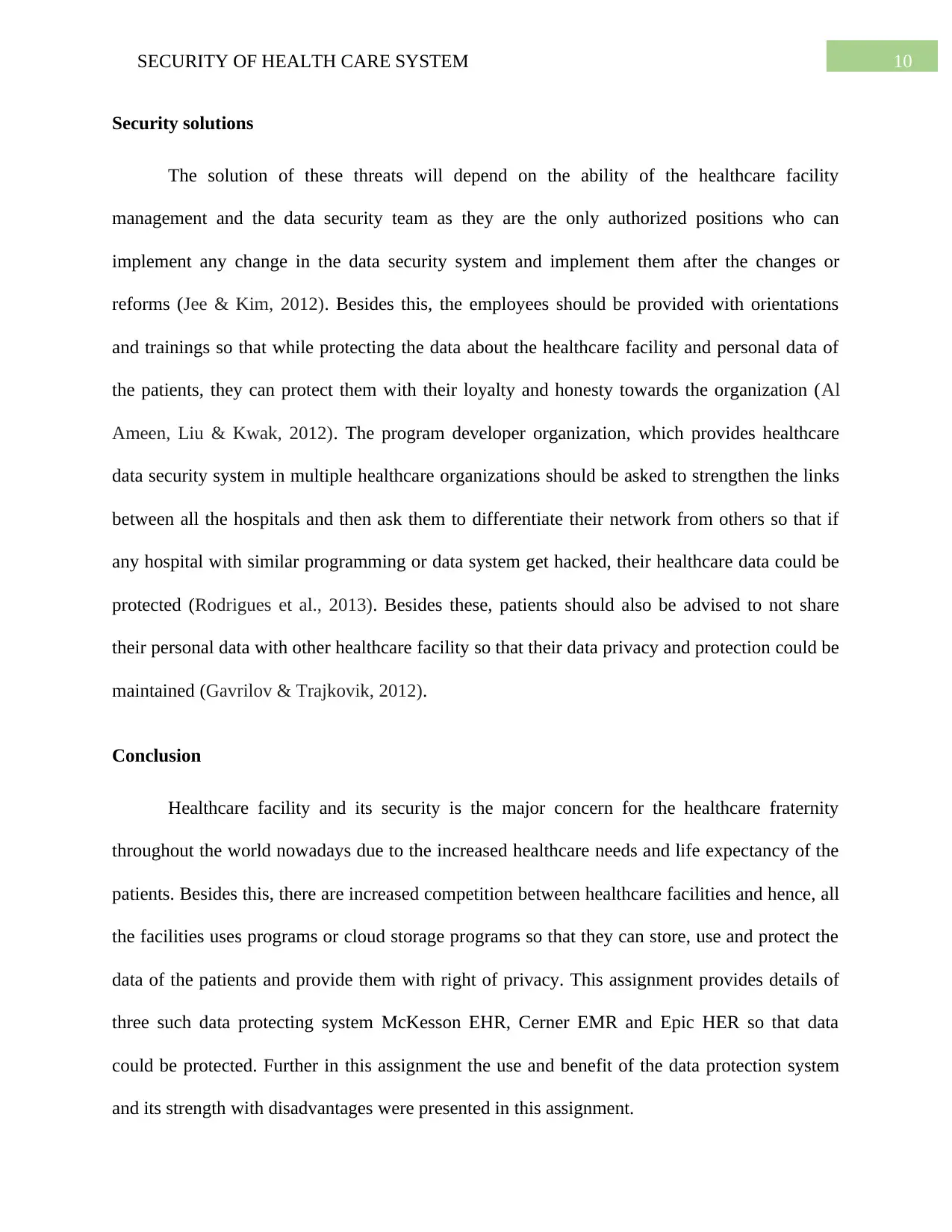
10SECURITY OF HEALTH CARE SYSTEM
Security solutions
The solution of these threats will depend on the ability of the healthcare facility
management and the data security team as they are the only authorized positions who can
implement any change in the data security system and implement them after the changes or
reforms (Jee & Kim, 2012). Besides this, the employees should be provided with orientations
and trainings so that while protecting the data about the healthcare facility and personal data of
the patients, they can protect them with their loyalty and honesty towards the organization (Al
Ameen, Liu & Kwak, 2012). The program developer organization, which provides healthcare
data security system in multiple healthcare organizations should be asked to strengthen the links
between all the hospitals and then ask them to differentiate their network from others so that if
any hospital with similar programming or data system get hacked, their healthcare data could be
protected (Rodrigues et al., 2013). Besides these, patients should also be advised to not share
their personal data with other healthcare facility so that their data privacy and protection could be
maintained (Gavrilov & Trajkovik, 2012).
Conclusion
Healthcare facility and its security is the major concern for the healthcare fraternity
throughout the world nowadays due to the increased healthcare needs and life expectancy of the
patients. Besides this, there are increased competition between healthcare facilities and hence, all
the facilities uses programs or cloud storage programs so that they can store, use and protect the
data of the patients and provide them with right of privacy. This assignment provides details of
three such data protecting system McKesson EHR, Cerner EMR and Epic HER so that data
could be protected. Further in this assignment the use and benefit of the data protection system
and its strength with disadvantages were presented in this assignment.
Security solutions
The solution of these threats will depend on the ability of the healthcare facility
management and the data security team as they are the only authorized positions who can
implement any change in the data security system and implement them after the changes or
reforms (Jee & Kim, 2012). Besides this, the employees should be provided with orientations
and trainings so that while protecting the data about the healthcare facility and personal data of
the patients, they can protect them with their loyalty and honesty towards the organization (Al
Ameen, Liu & Kwak, 2012). The program developer organization, which provides healthcare
data security system in multiple healthcare organizations should be asked to strengthen the links
between all the hospitals and then ask them to differentiate their network from others so that if
any hospital with similar programming or data system get hacked, their healthcare data could be
protected (Rodrigues et al., 2013). Besides these, patients should also be advised to not share
their personal data with other healthcare facility so that their data privacy and protection could be
maintained (Gavrilov & Trajkovik, 2012).
Conclusion
Healthcare facility and its security is the major concern for the healthcare fraternity
throughout the world nowadays due to the increased healthcare needs and life expectancy of the
patients. Besides this, there are increased competition between healthcare facilities and hence, all
the facilities uses programs or cloud storage programs so that they can store, use and protect the
data of the patients and provide them with right of privacy. This assignment provides details of
three such data protecting system McKesson EHR, Cerner EMR and Epic HER so that data
could be protected. Further in this assignment the use and benefit of the data protection system
and its strength with disadvantages were presented in this assignment.

11SECURITY OF HEALTH CARE SYSTEM
References
Ajami, S., & Bagheri-Tadi, T. (2013). Barriers for adopting electronic health records (EHRs) by
physicians. Acta Informatica Medica, 21(2), 129.
Al Ameen, M., Liu, J., & Kwak, K. (2012). Security and privacy issues in wireless sensor
networks for healthcare applications. Journal of medical systems, 36(1), 93-101.
Bahga, A., & Madisetti, V. K. (2013). A cloud-based approach for interoperable electronic health
records (EHRs). IEEE Journal of Biomedical and Health Informatics, 17(5), 894-906.
Duckett, S., & Willcox, S. (2015). The Australian health care system (No. Ed. 5). Oxford
University Press.
Faden, R. R., Kass, N. E., Goodman, S. N., Pronovost, P., Tunis, S., & Beauchamp, T. L. (2013).
An ethics framework for a learning health care system: a departure from traditional
research ethics and clinical ethics. Hastings Center Report, 43(s1), S16-S27.
Fernández-Cardeñosa, G., de la Torre-Díez, I., López-Coronado, M., & Rodrigues, J. J. (2012).
Analysis of cloud-based solutions on EHRs systems in different scenarios. Journal of
medical systems, 36(6), 3777-3782.
Gavrilov, G., & Trajkovik, V. (2012). Security and privacy issues and requirements for
healthcare cloud computing. ICT Innovations, 143-152.
Hashem, I. A. T., Yaqoob, I., Anuar, N. B., Mokhtar, S., Gani, A., & Khan, S. U. (2015). The
rise of “big data” on cloud computing: Review and open research issues. Information
systems, 47, 98-115.
References
Ajami, S., & Bagheri-Tadi, T. (2013). Barriers for adopting electronic health records (EHRs) by
physicians. Acta Informatica Medica, 21(2), 129.
Al Ameen, M., Liu, J., & Kwak, K. (2012). Security and privacy issues in wireless sensor
networks for healthcare applications. Journal of medical systems, 36(1), 93-101.
Bahga, A., & Madisetti, V. K. (2013). A cloud-based approach for interoperable electronic health
records (EHRs). IEEE Journal of Biomedical and Health Informatics, 17(5), 894-906.
Duckett, S., & Willcox, S. (2015). The Australian health care system (No. Ed. 5). Oxford
University Press.
Faden, R. R., Kass, N. E., Goodman, S. N., Pronovost, P., Tunis, S., & Beauchamp, T. L. (2013).
An ethics framework for a learning health care system: a departure from traditional
research ethics and clinical ethics. Hastings Center Report, 43(s1), S16-S27.
Fernández-Cardeñosa, G., de la Torre-Díez, I., López-Coronado, M., & Rodrigues, J. J. (2012).
Analysis of cloud-based solutions on EHRs systems in different scenarios. Journal of
medical systems, 36(6), 3777-3782.
Gavrilov, G., & Trajkovik, V. (2012). Security and privacy issues and requirements for
healthcare cloud computing. ICT Innovations, 143-152.
Hashem, I. A. T., Yaqoob, I., Anuar, N. B., Mokhtar, S., Gani, A., & Khan, S. U. (2015). The
rise of “big data” on cloud computing: Review and open research issues. Information
systems, 47, 98-115.

12SECURITY OF HEALTH CARE SYSTEM
Heart, T., Ben-Assuli, O., & Shabtai, I. (2017). A review of PHR, EMR and EHR integration: A
more personalized healthcare and public health policy. Health Policy and
Technology, 6(1), 20-25.
Jee, K., & Kim, G. H. (2013). Potentiality of big data in the medical sector: focus on how to
reshape the healthcare system. Healthcare informatics research, 19(2), 79-85.
Kim, G. H., Trimi, S., & Chung, J. H. (2014). Big-data applications in the government
sector. Communications of the ACM, 57(3), 78-85.
Nguyen, L., Bellucci, E., & Nguyen, L. T. (2014). Electronic health records implementation: an
evaluation of information system impact and contingency factors. International journal
of medical informatics, 83(11), 779-796.
Obama, B. (2016). United States health care reform: progress to date and next
steps. Jama, 316(5), 525-532.
Rodrigues, J. J., De La Torre, I., Fernández, G., & López-Coronado, M. (2013). Analysis of the
security and privacy requirements of cloud-based electronic health records
systems. Journal of medical Internet research, 15(8).
Roski, J., Bo-Linn, G. W., & Andrews, T. A. (2014). Creating value in health care through big
data: opportunities and policy implications. Health affairs, 33(7), 1115-1122.
Tarouco, L. M. R., Bertholdo, L. M., Granville, L. Z., Arbiza, L. M. R., Carbone, F., Marotta,
M., & de Santanna, J. J. C. (2012, June). Internet of Things in healthcare:
Heart, T., Ben-Assuli, O., & Shabtai, I. (2017). A review of PHR, EMR and EHR integration: A
more personalized healthcare and public health policy. Health Policy and
Technology, 6(1), 20-25.
Jee, K., & Kim, G. H. (2013). Potentiality of big data in the medical sector: focus on how to
reshape the healthcare system. Healthcare informatics research, 19(2), 79-85.
Kim, G. H., Trimi, S., & Chung, J. H. (2014). Big-data applications in the government
sector. Communications of the ACM, 57(3), 78-85.
Nguyen, L., Bellucci, E., & Nguyen, L. T. (2014). Electronic health records implementation: an
evaluation of information system impact and contingency factors. International journal
of medical informatics, 83(11), 779-796.
Obama, B. (2016). United States health care reform: progress to date and next
steps. Jama, 316(5), 525-532.
Rodrigues, J. J., De La Torre, I., Fernández, G., & López-Coronado, M. (2013). Analysis of the
security and privacy requirements of cloud-based electronic health records
systems. Journal of medical Internet research, 15(8).
Roski, J., Bo-Linn, G. W., & Andrews, T. A. (2014). Creating value in health care through big
data: opportunities and policy implications. Health affairs, 33(7), 1115-1122.
Tarouco, L. M. R., Bertholdo, L. M., Granville, L. Z., Arbiza, L. M. R., Carbone, F., Marotta,
M., & de Santanna, J. J. C. (2012, June). Internet of Things in healthcare:
Paraphrase This Document
Need a fresh take? Get an instant paraphrase of this document with our AI Paraphraser
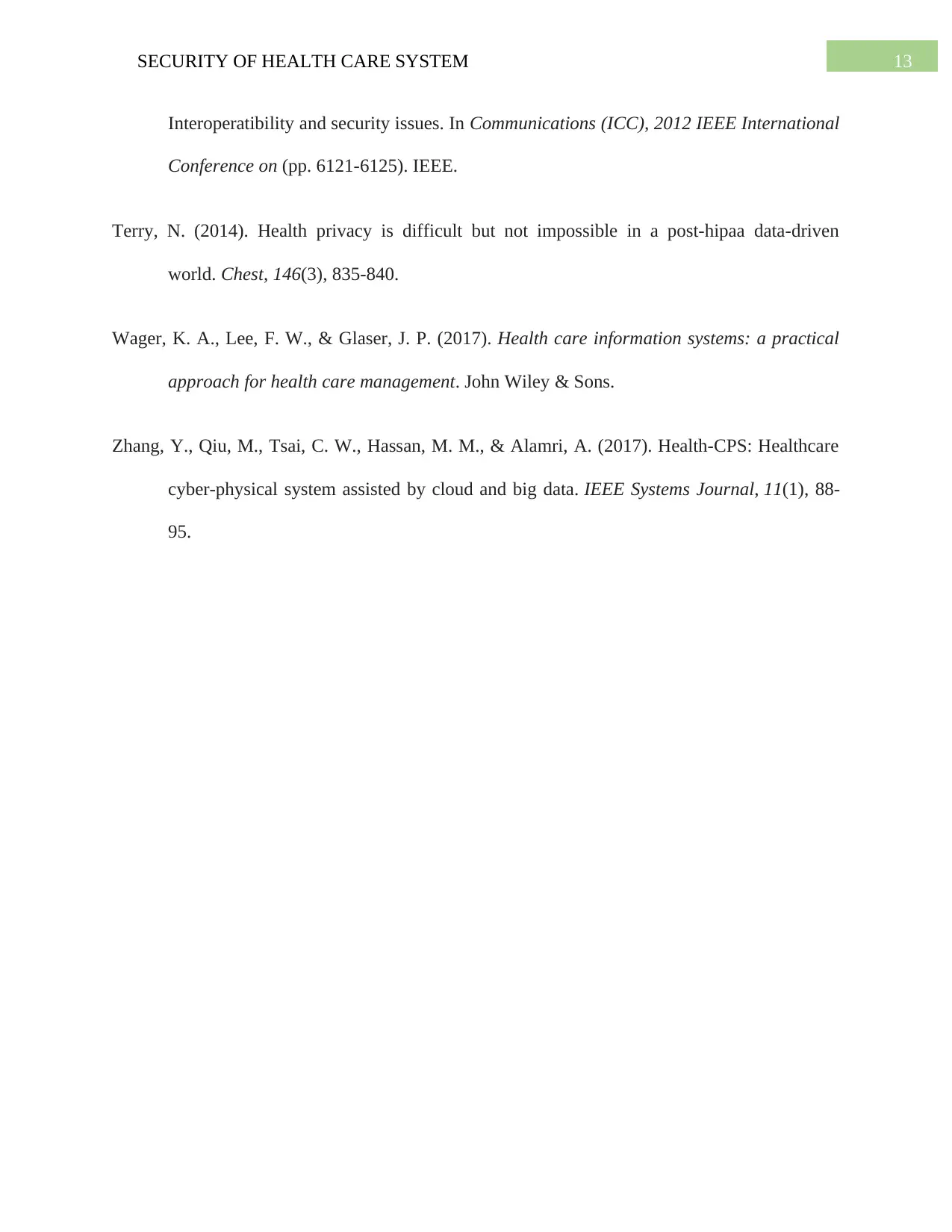
13SECURITY OF HEALTH CARE SYSTEM
Interoperatibility and security issues. In Communications (ICC), 2012 IEEE International
Conference on (pp. 6121-6125). IEEE.
Terry, N. (2014). Health privacy is difficult but not impossible in a post-hipaa data-driven
world. Chest, 146(3), 835-840.
Wager, K. A., Lee, F. W., & Glaser, J. P. (2017). Health care information systems: a practical
approach for health care management. John Wiley & Sons.
Zhang, Y., Qiu, M., Tsai, C. W., Hassan, M. M., & Alamri, A. (2017). Health-CPS: Healthcare
cyber-physical system assisted by cloud and big data. IEEE Systems Journal, 11(1), 88-
95.
Interoperatibility and security issues. In Communications (ICC), 2012 IEEE International
Conference on (pp. 6121-6125). IEEE.
Terry, N. (2014). Health privacy is difficult but not impossible in a post-hipaa data-driven
world. Chest, 146(3), 835-840.
Wager, K. A., Lee, F. W., & Glaser, J. P. (2017). Health care information systems: a practical
approach for health care management. John Wiley & Sons.
Zhang, Y., Qiu, M., Tsai, C. W., Hassan, M. M., & Alamri, A. (2017). Health-CPS: Healthcare
cyber-physical system assisted by cloud and big data. IEEE Systems Journal, 11(1), 88-
95.
1 out of 14
Related Documents
Your All-in-One AI-Powered Toolkit for Academic Success.
+13062052269
info@desklib.com
Available 24*7 on WhatsApp / Email
![[object Object]](/_next/static/media/star-bottom.7253800d.svg)
Unlock your academic potential
© 2024 | Zucol Services PVT LTD | All rights reserved.





